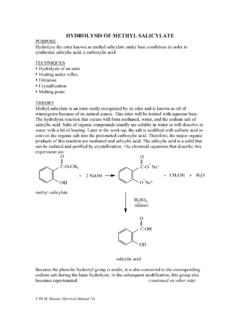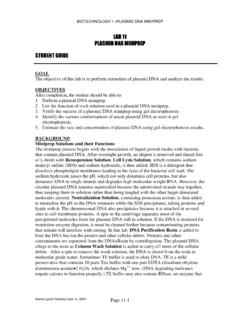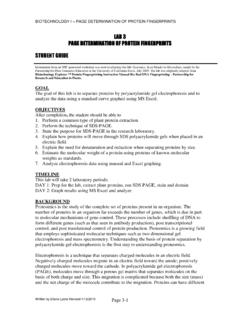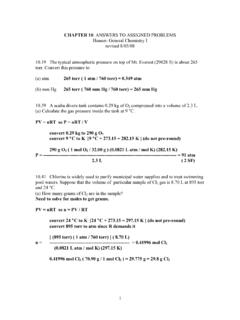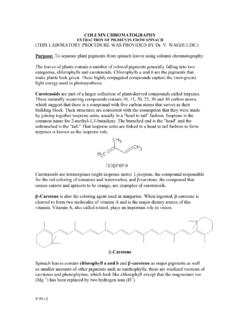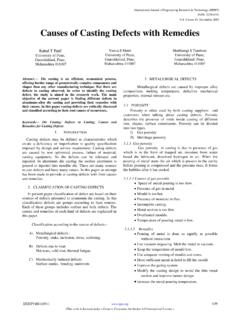Transcription of CHAPTER 5: ANSWERS TO ASSIGNED PROBLEMS Hauser- …
1 1 CHAPTER 5: ANSWERS TO ASSIGNED PROBLEMS Hauser- General Chemistry I revised 10/14/08 CAUTION: Many different units are used in thermochemistry. Report the units! Also report the sign when appropriate! Consider the following reaction: 2 Mg (s) + O2 (g) 2 MgO (s) H = -1204 kJ (a) Is this reaction exothermic or endothermic? EXOTHERMIC (negative H) (b) Calculate the amount of heat transferred when g of Mg (s) reacts at constant pressure. g Mg ( 1 mol Mg / g) ( -1204 kJ / 2 mol Mg) = -59 kJ (2 SF) COEFFICIENTS MATTER! Note the 2 for Mg. When solutions containing silver ions and chloride ions are mixed, silver chloride precipitates: Ag+ (aq) + Cl- (aq) AgCl (s) H = kJ (a) Calculate H for production of mol of AgCl by this reaction. mol AgCl ( kJ / 1 mol AgCl) = kJ (b) Calculate H for the production of g of AgCl.
2 Ag 1 X Cl 1 X sum = g AgCl ( 1 mole AgCl / g ) ( kJ / 1 mole AgCl ) = - kJ 2 The specific heat of iron metal is J/g-K. How many J of heat are necessary to raise the temperature of a kg block of iron from C to C? q = C m T get C from table or from problem ( J / g-K) Since C and K have the same "size," the T does not require conversion to K. T = Tf T I Note: ( = ) gives 1 dp and 3 SF for these #s m = kg ( 1000 g / 1 kg) = 1050 g q = ( J / g-C) (1050 g ) ( C C) = J = X 104 J (3 SF) Answer must show size and SF. Note: Question asked for HOW MANY, so a positive answer is appropriate. What is the connection between Hess s law and the fact that H is a state function? H is path-independent so any # of steps will give the true H for the overall process. Calculate the enthalpy change for the reaction P4O6 (s) + 2 O2 (g) P4O10 (s) given the following enthalpies of reaction: EQ 1 P4 (s) + 3 O2 (g) P4O6 (s) H = kJ EQ 2 P4 (s) + 5 O2 (g) P4O10 (s) H = kJ Use Hess's Law.
3 Identify a substance unique to only one DATA equation. Focus on handling that substance in each case. REVERSE EQ 1 to get P4O6 on left side; reverse sign EQ 2 stays same to keep P4O10 on right side. P4O6 (s) P4 (s) + 3 O2 (g) H = + kJ P4 (s) + 5 O2 (g) P4O10 (s) H = kJ create "grand" equation and subtract common items P4O6 + P4 + 5 O2 P4 + 3 O2 + P4O10 both P4 's leave and, after subtracting 3 O2, get 2 O2 's on left side. P4O6 (s) + 2 O2 (g) P4O10 (s) sum the H 's : + kJ kJ dp rule ANSWER: H = kJ 3 From the enthalpies of reaction EQ 1 H2 (g) + F2 (g) 2 HF (g) H = -537 kJ EQ 2 C (s) + 2 F2 (g) CF4 (g) H = -680 kJ EQ 3 2 C (s) + 2 H2 (g) C2H4 (g) H = + kJ calculate H for the reaction of ethylene with F2 C2H4 (g) + 6 F2 (g) 2 CF4 (g) + 4 HF (g) Identify a substance unique to only one DATA equation.
4 Focus on handling that substance in each case. DOUBLE EQ 1 to get 4HF (double H) DOUBLE EQ 2 to get 2 CF4 (double H) REVERSE EQ 3 to get C2H4 on left side. (reverse sign H) 2H2 (g) + 2F2 (g) 4 HF (g) 2 H = 2 (-537 kJ) = -1074 kJ 2C (s) + 4 F2 (g) 2CF4 (g) 2 H = 2 (-680 kJ) = -1360 kJ C2H4 (g) 2 C (s) + 2 H2 (g) - H = - (+ kJ) = kJ sum equations 2H2 + 2F2 + 2C + 4 F2 + C2H4 2CF4 + 4 HF + 2 C + 2 H2 combine F2 C2H4 + 6 F2 2CF4 + 4 HF sum the adjusted H values: -1074 kJ -1360 kJ - kJ sum = - 2486 kJ (Prof H. says to use dp rules since we multiply by counting #s then add: so no dp for this value here) 4 The following is known as the thermite reaction 2 Al (s) + Fe2O3 (s) Al2O3 (s) + 2 Fe (s) This highly exothermic reaction is used for welding massive units, such as propellers for large ships.
5 Using standard enthalpies of formation in Appendix C, calculate H for this reaction. Use Enthalpy of Formation data and equation: Note the standard state symbol and "f". DO NOT USE HESS'S LAW! H rxn = H f (products) - H f (reactants) [ H f Al2O3 (s) + 2 H f Fe (s) ] [2 H f Al (s) + H f Fe2O3 (s)] [- kJ + 2 (0) ] [ 2 (0) + kJ] kJ [ kJ] H rxn = - reported to 1 dp based on data = kJ Using values from Appendix C, calculate the standard enthalpy change for the following reaction: (c) N2O4 (g) + 4 H2 (g) N2 (g) + 4 H2O (g) WATCH PHASES! H rxn = H f (products) - H f (reactants) [ H f N2 (g) + 4 H f H2O (g) ] - [ H f N2O4 (g) + 4 H f H2 (g)] [ 0 + 4 ( kJ)] - [ kJ + 4 (0) ] DO NOT PRE-ROUND! [- kJ ] - [ kJ ] H rxn = kJ (2 dp based on data)

